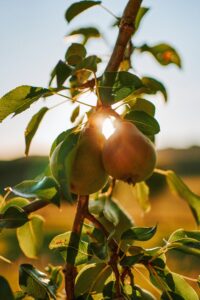 It can be rewarding to enjoy the fruits from a tree on your property, but it doesn’t come without work and knowledge. Fruit trees do need some maintenance in the home landscape, but with the right plan, you can be harvesting the fruits of your labor.
It can be rewarding to enjoy the fruits from a tree on your property, but it doesn’t come without work and knowledge. Fruit trees do need some maintenance in the home landscape, but with the right plan, you can be harvesting the fruits of your labor.
If you are planting a new fruit tree, be sure you consider its needs and mature size. Many fruit trees can be large, especially if they are not pruned properly. Most fruit trees are available in dwarf varieties, which are smaller and better suited to a small space in a home landscape. Fruit trees are not tolerant of soils with poor drainage, or sites with heavy irrigation. This means that your lawn isn’t the ideal place to plant a fruit tree.
Fruit trees will need proper nutrition to produce fruit. Which nutrients you need to apply, and the amount required, can be determined by a soil test. Most fruit tree fertilizers will be broadcast evenly underneath the tree and watered in.
Of course, having a fruit tree in your landscape can lead to challenges. Pollination is one of the most common issues homeowners face. Bees do not fly in cool, rainy weather, which is common in the springtime when pollination is needed. Trees like apricots, peaches, and nectarines are usually self-pollinated, whereas trees such as apples, and pears are cross pollinated and need a compatible cultivar to be planted within 100 feet for adequate pollination to occur.
Another issue that you can’t do much about is spring frost. A late spring frost can damage the forming buds and lead to a poor harvest that year.
There are also many pests and diseases that most fruit trees are susceptible to. CSU Extension has many fact sheets that can guide you through treating and preventing insects and diseases, search them on the web or call the Extension office to find the appropriate fact sheet for your situation.
Fruit trees must be pruned and trained to produce the best fruit. Training is the structural shaping of the tree, usually done when the tree is young. Annual pruning is done yearly to help the tree produce the best fruit. We have some great guides on how to properly prune and train your fruit trees.
If you have a fruit tree on your property that you cannot harvest all the fruit from, a local organization called UpRoot Colorado can help! They have volunteers and harvesting equipment that they can use to help homeowners harvest their fruit trees. Harvested fruit is donated to local food banks, so you are helping your community as well. If you are interested, contact Sierra at sierra@uprootcolorado.org.


